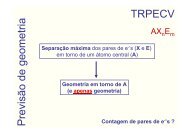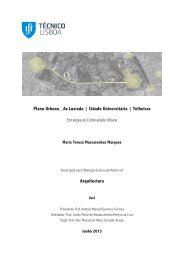Jorge Manuel de Oliveira Vicente Tese de Mestrado em Engenharia ...
Jorge Manuel de Oliveira Vicente Tese de Mestrado em Engenharia ...
Jorge Manuel de Oliveira Vicente Tese de Mestrado em Engenharia ...
You also want an ePaper? Increase the reach of your titles
YUMPU automatically turns print PDFs into web optimized ePapers that Google loves.
eing <strong>de</strong>livered is in or<strong>de</strong>r. It also may be seen as a way to add more value to the service and,<br />
ultimately, <strong>de</strong>rive more revenue.<br />
Furthermore, SLAs will need to be renegotiated as volume grows. Growth will also lead to<br />
improv<strong>em</strong>ents in the infrastructure and the ability to raise service levels. New services will be<br />
created, and SLM will expand into other areas of the business and other areas of the<br />
infrastructure. Services may be outsourced, or brought in-house.<br />
Finally, the unstated sixth step of the SLM process is “Repeat.” The process must be<br />
regularly scrutinized for relevance, accuracy, etc. The manager or executive responsible for<br />
providing the service covered by the SLM process must always be examining both the process<br />
and the service, looking for ways to improve both.<br />
2.2.5. Costs and Benefits<br />
What value can SLM bring to the enterprise? This is a critical question, not only because it<br />
justifies the <strong>de</strong>cision to invest in SLM, but also because it asks enterprises to evaluate the<br />
effectiveness of SLM technologies and processes after they have been <strong>de</strong>ployed. A truly<br />
effective SLM initiative will not only <strong>de</strong>liver a quick return on investment (ROI) on the initial<br />
technology and resource investment, but will continue to produce cost savings, improved<br />
productivity, and greater customer satisfaction throughout its lifetime [2].<br />
When weighing the value of SLM to your organization, it is important to consi<strong>de</strong>r:<br />
• The direct and indirect costs<br />
• The tangible and intangible benefits<br />
• The real and perceived risks<br />
In general, the costs of SLM can be broken into two categories:<br />
• IT costs<br />
• Business unit/user costs<br />
IT Costs<br />
While an effective SLM initiative will involve both IT and business groups, it is IT that<br />
generally bears the brunt of the resource costs associated with SLM impl<strong>em</strong>entation. It is IT that<br />
will be called upon not only to help establish and maintain service levels, but to provi<strong>de</strong> the<br />
instrumentation required to measure and monitor th<strong>em</strong>.<br />
There are several categories of direct IT costs in SLM:<br />
17

















